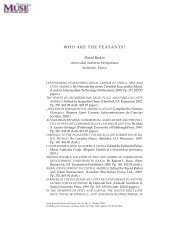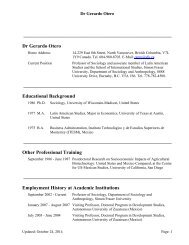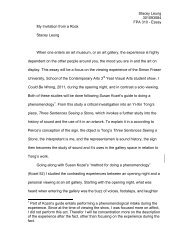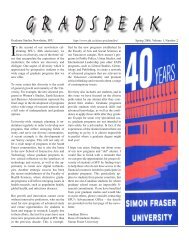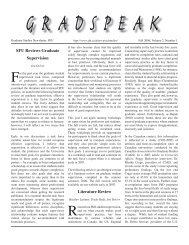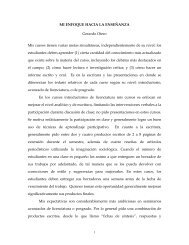Link - Simon Fraser University
Link - Simon Fraser University
Link - Simon Fraser University
You also want an ePaper? Increase the reach of your titles
YUMPU automatically turns print PDFs into web optimized ePapers that Google loves.
656 M. W. Hart and P. B. Markounderstanding of population history across each species’range), and species (for comparative analyseswithin communities or within higher taxa). In spiteof a decade of advice from reviews, models, andsimulation studies to ‘‘add loci’’, a glance at therecent literature shows that many larval ecologistshave found it difficult to satisfy all five of these imperatives,and many have found it necessary insteadto trade-off some against others, most often byrelying on single-locus mtDNA analyses that usehighly reliable PCR methods for previously wellcharacterizedmitochondrial genes, and avoid thelabor, expense, and errors associated with cloningPCR products from heterozygotes at nuclear loci.It seems likely that many of these cases stem fromlack of knowledge of the nuclear genome of thestudy organism, or the perceived difficulty of developingPCR primers for polymorphic nuclear genesequences.The effects of dependence on mtDNA alone (andthe need for multiple loci in order to take full advantageof the insights from IMA and other coalescentMCMC methods) are apparent in the resultsfrom some recent comparative phylogeographicalstudies whose design and research questions weredirectly relevant to the goals of our review butwhich yielded inconclusive results from IM or IMAanalysis. Teske et al. (2007) reported variation inpatterns of mtDNA spatial differentiation (F ST ) insouthern Africa among five sympatric rocky-shorespecies that was correlated with the mode of larvaldevelopment in a predictable way (higher for specieswithout planktonic larvae). However, IM estimates ofpopulation parameters from those mtDNA sequencealignments were ambiguous in the sense that theposterior distributions of most estimated migrationrates and population divergence times had weaklydefined lower bounds (including zero) and upperbounds (the posterior probabilities for the highestparameter values failed to decline to zero withinthe range of the prior distribution). Similarly,Crandall et al. (2008) followed a heroic samplingdesign that included 1182 individuals and 133 populationsfrom 97 localities spanning the 7000 kmeast–west range of two closely related Nerita gastropods.Crandall et al. found striking differences betweenthe large-scale phylogeographic structures inmtDNA sequence alignments from these two species(which have similar high-dispersal modes of larvaldevelopment), but were unable to use IM to comparethe population demographic histories underlyingthose two different patterns of spatial variationbecause one of the sequence alignments stubbornlyresisted all efforts to converge on a reliable IM result.Instead, Crandall et al. used alternative methods(Bayesian skyline plots) to infer differences amongspecies and lineages in the history of variation ineffective population size but without jointly estimatingvariation in migration rates or population divergencetimes (as in IM). In an analogous study (ofecotypes within a snail species complex, rather thanamong species with different distributions or modesof development), Quesada et al. (2007) found thatmtDNA sequences alone could clearly identify fourgeographically distinct parallel divergences betweenthe two ecotypes, but three of those four populationdivergence times could not be estimated with anyprecision in IM (with poorly defined posterior distributionsas described above). In all three of thesecases, the inability to resolve the population demographichistories that underlie the observed patternsof mtDNA spatial differentiation does not invalidatethe characterization of those spatial patterns, but itdoes prevent us from discovering whether the spatialdifferentiation is a direct reflection of differences inrates of gene flow, or a more complex outcome ofdifferent population histories, divergence times, andpatterns of change in population size. It seems likelythat in all three of these cases (and others we havenot reviewed that did not focus on marine invertebratepopulations), mtDNA variation alone containedtoo little coalescent information for the jointestimation of many demographic parameters, andthat greater sampling of loci (with the same oreven less intensive sampling of nucleotides, individuals,and populations) could have sidestepped theselimitations on the coalescent information contentfrom mtDNA alone.An important but underappreciated considerationin the development of new nuclear sequence alignmentsfor coalescent population genetic analyses isthe potential bias in marker selection associatedwith a historic preference for highly variable markers.In the past, a standard procedural step in the processof development of genetic markers used by manypopulation geneticists was to ‘‘screen loci for polymorphism’’by focusing on loci with high levels ofallelic variation in test samples and discarding thosewith low levels of polymorphism. Although loci withlow levels of polymorphisms are not useful for studiesof individuality (e.g., kinship and parentage) orfor some methods that attempt to infer recent dispersalevents using multilocus linkage disequilibrium(e.g., STRUCTURE, BAYESASS), loci with low levels ofnucleotide and haplotype diversity can provide importantinformation about variance in the coalescentprocess. Because the relative mutation rates of lociare estimated separately in IMA (i.e., each locusDownloaded from icb.oxfordjournals.org at <strong>Simon</strong> <strong>Fraser</strong> <strong>University</strong> on November 2, 2010



